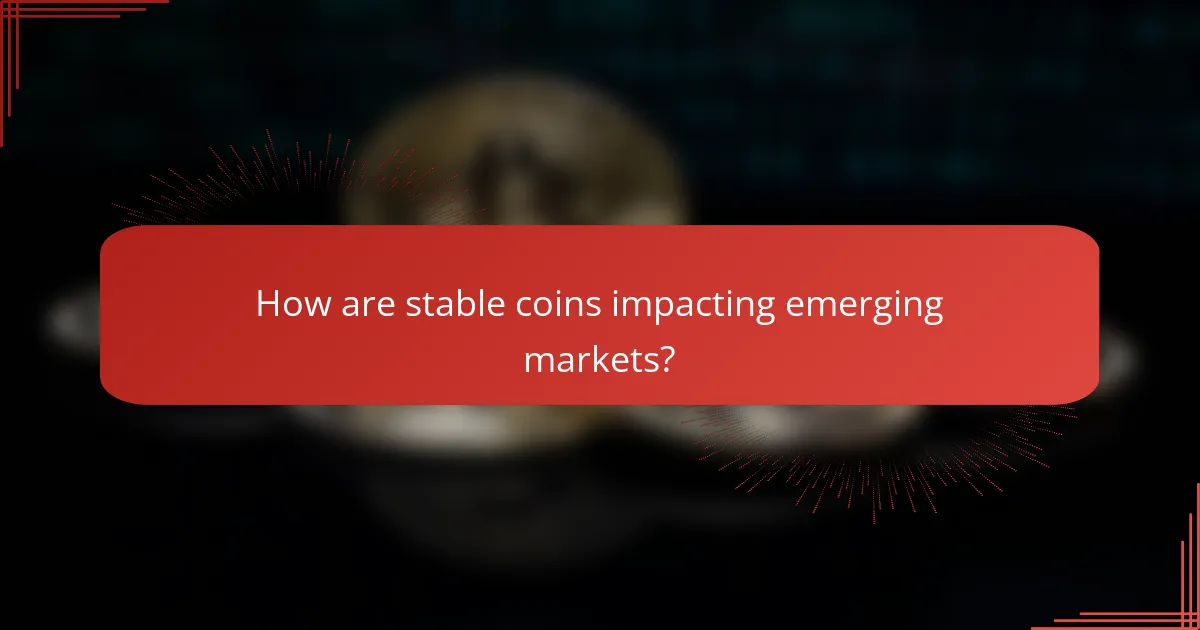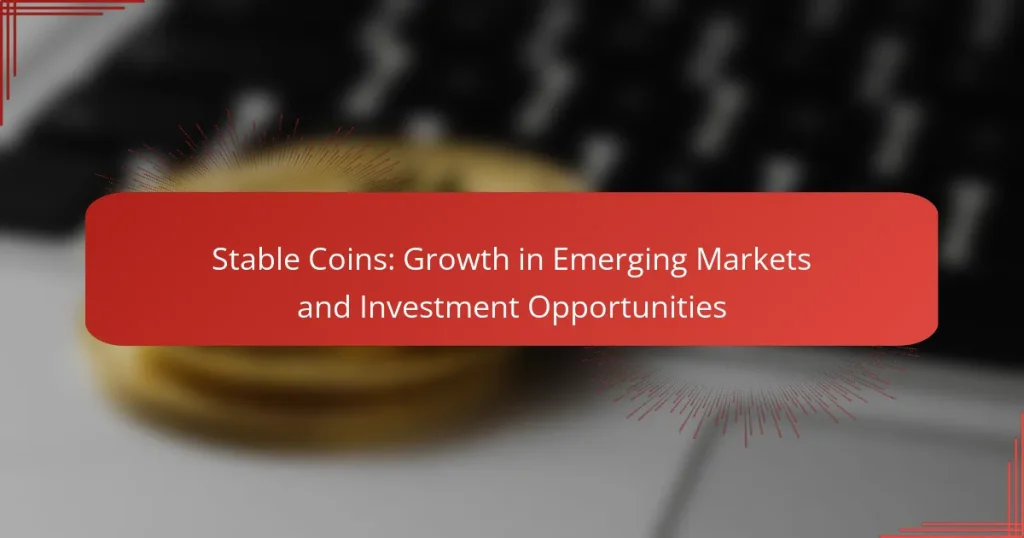Stable coins are transforming emerging markets by offering a reliable digital currency alternative that enhances financial transactions in regions with unstable local currencies. Their capacity to maintain value relative to traditional currencies makes them appealing for users seeking stability. Additionally, these digital assets present diverse investment opportunities, including yield generation and inflation hedging, attracting both individual and institutional investors.

How are stable coins impacting emerging markets?
Stable coins are significantly influencing emerging markets by providing a stable digital currency alternative that enhances financial transactions. Their ability to maintain value relative to traditional currencies makes them an attractive option for users in regions with volatile local currencies.
Increased financial inclusion
Stable coins promote financial inclusion by offering unbanked populations access to digital financial services. With just a smartphone and internet connection, individuals can participate in the global economy without needing a traditional bank account.
This accessibility allows users to save, invest, and transact with lower fees compared to conventional banking systems, which often exclude those in remote or underserved areas.
Facilitated cross-border transactions
Stable coins simplify cross-border transactions by reducing the time and costs associated with currency conversion and international transfers. Users can send and receive funds almost instantly, avoiding the delays common with traditional banking methods.
For example, a small business in Nigeria can easily pay a supplier in Europe using a stable coin, minimizing exchange rate risks and transaction fees that can reach up to several percentage points of the total amount.
Enhanced remittance efficiency
Stable coins improve remittance efficiency by providing a cost-effective alternative to traditional money transfer services. Families sending money back home can save on fees, which often consume a significant portion of the funds sent.
In many emerging markets, remittance costs can exceed 7% of the transaction value. By using stable coins, these costs can be reduced to just a fraction of that, allowing recipients to receive more of the intended amount.
Stabilized local currencies
In regions with high inflation or currency instability, stable coins can serve as a hedge against local currency depreciation. Users can convert their savings into stable coins, protecting their wealth from the volatility of their national currency.
This practice is particularly relevant in countries facing hyperinflation, where stable coins can provide a more reliable store of value, thus fostering economic stability and confidence among consumers and businesses alike.

What investment opportunities do stable coins offer?
Stable coins provide various investment opportunities, particularly in emerging markets where traditional financial systems may be less accessible. They offer potential for yield generation, liquidity in decentralized finance, and a hedge against inflation, making them attractive for both individual and institutional investors.
Yield farming with stable coins
Yield farming involves lending or staking stable coins to earn interest or rewards, often significantly higher than traditional savings accounts. Investors can utilize platforms like Aave or Compound, where stable coins can generate annual percentage yields (APY) ranging from low single digits to over 10% depending on market conditions.
However, yield farming carries risks such as smart contract vulnerabilities and market volatility. It’s crucial to research the platforms and understand the terms before committing funds.
Liquidity provision in decentralized finance
Providing liquidity in decentralized finance (DeFi) allows investors to earn fees by adding stable coins to liquidity pools on exchanges like Uniswap or SushiSwap. This process can yield returns while contributing to the overall market efficiency of decentralized trading.
Investors should be aware of impermanent loss, which can occur when the value of the stable coin fluctuates compared to other assets in the pool. Diversifying across multiple pools can help mitigate this risk.
Hedging against inflation
Stable coins can serve as a hedge against inflation, especially in countries experiencing economic instability or high inflation rates. By holding stable coins pegged to strong currencies like the US dollar, investors can preserve their purchasing power more effectively than in local fiat currencies.
To maximize this strategy, consider converting local currency into stable coins during inflationary periods. However, be mindful of regulatory considerations and potential transaction fees when converting assets.

Which stable coins are popular in emerging markets?
In emerging markets, stable coins like Tether (USDT), USD Coin (USDC), and TrueUSD (TUSD) are gaining traction due to their ability to provide stability in volatile economies. These digital currencies offer a reliable alternative for transactions and savings, often pegged to the US dollar.
Tether (USDT)
Tether (USDT) is one of the most widely used stable coins globally, especially in emerging markets. It is pegged to the US dollar, which helps users avoid the volatility associated with local currencies.
Many users in countries facing inflation or currency devaluation turn to USDT for remittances and trading on cryptocurrency exchanges. Its liquidity and widespread acceptance make it a practical choice for individuals and businesses alike.
USD Coin (USDC)
USD Coin (USDC) is another popular stable coin that offers a strong alternative in emerging markets. Like Tether, it is pegged to the US dollar, ensuring that its value remains stable.
USDC is often favored for its transparency and regulatory compliance, as it is issued by regulated financial institutions. This can provide users with a sense of security, making it a preferred option for those looking to engage in digital finance without the risks associated with local currencies.
TrueUSD (TUSD)
TrueUSD (TUSD) is a lesser-known but growing stable coin that also maintains a 1:1 peg with the US dollar. It emphasizes transparency and regular audits, which can appeal to users in emerging markets seeking reliability.
With its focus on compliance and trust, TUSD can be an attractive option for individuals and businesses wanting to transact in a stable digital currency while minimizing exposure to local economic fluctuations.

What are the risks associated with stable coins?
Stable coins carry several risks that investors should consider, including regulatory uncertainties, market volatility, and counterparty risks. Understanding these factors is crucial for making informed investment decisions in this evolving financial landscape.
Regulatory uncertainties
Regulatory uncertainties pose a significant risk for stable coins, as governments worldwide are still developing frameworks to govern their use. In many emerging markets, the lack of clear regulations can lead to sudden changes in legal status, impacting the stability and usability of these digital assets.
Investors should keep abreast of local regulations, as compliance can vary widely. For instance, some countries may impose strict licensing requirements, while others might ban stable coins altogether, creating an unpredictable environment for users.
Market volatility
Despite being designed to maintain a stable value, stable coins can still experience market volatility, particularly during periods of high demand or panic. Factors such as liquidity issues or sudden shifts in investor sentiment can lead to temporary price fluctuations, which may impact trading strategies.
Investors should be aware that while stable coins aim to peg their value to fiat currencies, they are not immune to market forces. It’s advisable to monitor the trading volume and market conditions regularly to mitigate potential risks.
Counterparty risks
Counterparty risks arise when the entity backing a stable coin fails to maintain the necessary reserves or faces financial difficulties. This can lead to a loss of confidence in the stable coin, potentially causing its value to deviate from its intended peg.
To minimize counterparty risks, investors should choose stable coins backed by reputable organizations with transparent reserve management practices. Reviewing audit reports and understanding the backing mechanism can provide insights into the reliability of a stable coin.

How to choose the right stable coin for investment?
Choosing the right stable coin for investment involves assessing its stability, liquidity, and regulatory compliance. Investors should prioritize coins that maintain a consistent value and are widely accepted in the market.
Assessing stability mechanisms
Stability mechanisms are essential for ensuring that a stable coin maintains its value. Common mechanisms include fiat-collateralization, where each coin is backed by a reserve of a fiat currency, and algorithmic stabilization, which adjusts supply based on demand. For instance, Tether (USDT) is backed by USD reserves, while TerraUSD (UST) uses algorithms to manage supply.
When evaluating stability, consider the transparency of the reserves and the auditing practices of the issuing entity. Look for coins that provide regular reports or third-party audits to verify their backing.
Evaluating liquidity options
Liquidity refers to how easily a stable coin can be bought or sold without significantly affecting its price. High liquidity is crucial for investors who may need to convert their holdings quickly. Popular stable coins like USDC and DAI generally have higher liquidity due to their widespread use across various exchanges.
To assess liquidity, check trading volumes on major exchanges and the number of trading pairs available. A stable coin with low trading volume may pose risks when attempting to sell or convert it.
Understanding regulatory compliance
Regulatory compliance is vital for stable coins, as it impacts their legality and acceptance in different jurisdictions. Coins that adhere to local regulations are less likely to face legal challenges, making them safer investment options. For example, in the European Union, stable coins must comply with the Markets in Crypto-Assets (MiCA) regulation.
Investors should research the regulatory status of a stable coin in their country. Look for coins that have obtained necessary licenses or are actively working towards compliance to mitigate risks associated with regulatory changes.


